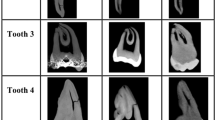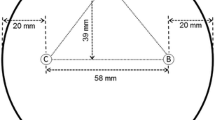Abstract
Objectives
Artifacts including scratches and dirt artifacts on the digital intraoral radiographs finally contribute to making inaccurate diagnoses. The aim of this study was to reduce the incidence of artifacts using dual imaging plates (DIPs) in imaging processing.
Methods
Conventional X-rays were taken of a porcine mandible embedded in acrylic resin using a DIP which consists of a front IP (FIP) and a back IP (BIP) with some scratches and dirt. The two images of the FIP and BIP were then synthesized and averaged to obtain a conventional DIP image. The following image processing method was used to make a DIP with artifact reduction (DIP+AR) image. A subtraction image of the FIP and BIP was constructed and the standard deviation (SD) was calculated. If the pixel value was over 3SD on the subtraction images, the pixel value of the DIP was swapped with the value on the opposite side of the non-artifact pixel. The conventional and DIP+AR images were also subjectively evaluated.
Results
Image processing to create a DIP+AR image was able to reduce the number of artifacts. Medians of number of artifacts evaluated were 2.00 [interquartile range (IQR), 2.50] in DIP images and 0.67 (IQR, 1.29) in DIP+AR images, indicating a significant reduction of number of artifacts in DIP+AR images.
Conclusions
DIP+AR image processing can reduce the incidence of artifacts caused by scratches and dirt, and could extend the lifespan of the IP and contribute accurate diagnosis in oral radiology.






Similar content being viewed by others

References
Kashima I, Kanno M, Higashi T, Takano M. Computed panoramic tomography with scanning laser-stimulated luminescence. Oral Surg Oral Med Oral Pathol. 1985;60:448–53. https://doi.org/10.1016/0030-4220(85)90270-1.
Kashima I, Sakurai T, Matsuki T, Makamura K, Aoki H, Ishii M. Intraoral computed radiography using the Fuji computed radiography imaging plate. Oral Surg Oral Med Oral Pathol. 1994;78:239–46. https://doi.org/10.1016/0030-4220(94)90154-6.
Møystad A, Svanaes DB, Risnes S, Larheim TA, Gröndahl HG. Detection of approximal caries with a storage phosphor system. A comparison of enhanced digital images with dental X-ray film. Dentomaxillofac Radiol. 1996;25:202–6. https://doi.org/10.1259/dmfr.25.4.9084274.
Hintze H, Wenzel A, Frydenberg M. Accuracy of caries detection with four storage phosphor systems and E-speed radiographs. Dentomaxillofac Radiol. 2002;31:170–5. https://doi.org/10.1038/sj/dmfr/4600686.
Møystad A, Svanaes DB, van der Stelt PF, Gröndahl H-G, Wenzel A, van Ginkel FC, et al. Comparison of standard and task-specific enhancement of Digora storage phosphor images for approximal caries diagnosis. Dentomaxillofac Radiol. 2003. https://doi.org/10.1259/dmfr/76382099.
Kajan ZD, Tayefeh Davalloo R, Tavangar M, Valizade F. The effects of noise reduction, sharpening, enhancement, and image magnification on diagnostic accuracy of a photostimulable phosphor system in the detection of non-cavitated approximal dental caries. Imaging Sci Dent. 2015;45:81–7. https://doi.org/10.5624/isd.2015.45.2.81.
Wenzel A. Radiographic modalities for diagnosis of caries in a historical perspective: from film to machine-intelligence supported systemsRadiographic modalities for diagnosis of caries in a historical perspective: from film to machine-intelligence supported systems. Dentomaxillofac Radiol. 2021;50:20210010. https://doi.org/10.1259/dmfr.20210010.
Bedard A, Davis TD, Angelopoulos C. Storage Phosphor plates: how durable are they as a digital dental radiographic system? J Contemp Dent Pract. 2004;5:57–69.
Chiu HL, Lin SH, Chen CH, Wang WC, Chen JY, Chen YK, Lin LM. Analysis of photostimulable phosphor plate image artifacts in an oral and maxillofacial radiology department. Oral Surg Oral Med Oral Pathol Oral Radiol Endod. 2008;106:749–56. https://doi.org/10.1016/j.tripleo.2008.01.003.
Kalathingal SM, Shrout MK, Comer C, Brady C. Rating the extent of surface scratches on photostimulable storage phosphor plates in a dental school environment. Dentomaxillofac Radiol. 2010;39:179–83. https://doi.org/10.1259/dmfr/28972644.
Gulsahi A, Secgin CK. Assessment of intraoral image artifacts related to photostimulable phosphor plates in a dentomaxillofacial radiology department. Niger J Clin Pract. 2016;19:248–53. https://doi.org/10.4103/1119-3077.164338.
Çalışkan A, Sumer. Definition, classification and retrospective analysis of photostimulable phosphor image artefacts and errors in intraoral dental radiography. Dentomaxillofac Radiol. 2017;46:20160188. https://doi.org/10.1259/dmfr.20160188.
Elkhateeb SM, Aloyouny AY, Omer MMS, Mansour SM. Analysis of photostimulable phosphor image plate artifacts and their prevalence. World J Clin Cases. 2022;10:437–47. https://doi.org/10.12998/wjcc.v10.i2.437.
Watanabe K, Imanishi Y, Kato M, Kimoto H, Sekiguchi T, Amemiya T, et al. Preliminary evaluation of dual imaging plate intraoral radiography. J Oral Sci. 2022;64:69–73. https://doi.org/10.2334/josnusd.21-0454.
Griindahl HG, Griindahl K, Okano T, Webber RL. Statistical contrast enhancement of subtraction images for radiographic caries diagnosis. Oral Surg Oral Med Oral Pathol. 1982;53:219–23. https://doi.org/10.1016/0030-4220(82)90292-4.
Wenzel A. Effect of manual compared with reference point superimposition on image quality in digital subtraction radiography. Dentomaxillofac Radiol. 1989;18:145–50. https://doi.org/10.1259/dmfr.18.4.2701173.
Halse A, White SC, Espelid I, Tveit AB. Visualization of stannous fluoride treatment of carious lesions by subtraction radiography. Oral Surg Oral Med Oral Pathol. 1990;69:378–81. https://doi.org/10.1016/0030-4220(90)90305-c.
Ohki M. Single Exposure dual energy imaging in intra-oral radiography. Oral Radiol. 1991;7:111–20.
Wenzel A, Halse A. Digital subtraction radiography after stannous fluoride treatment for occlusal caries diagnosis. Oral Surg Oral Med Oral Pathol. 1992;74:824–8. https://doi.org/10.1016/0030-4220(92)90416-n.
Haiter-Neto F, Wenzel A. Noise in subtraction images made from pairs of bitewing radiographs: a comparison between two subtraction programs. Dentomaxillofac Radiol. 2005;34:357–61. https://doi.org/10.1259/dmfr/15631269.
Kozakiewicz M, Bogusiak K, Hanclik M, Denkowski M, Arkuszewski P. Noise in subtraction images made from pairs of intraoral radiographs: a comparison between four methods of geometric alignment. Dentomaxillofac Radiol. 2008;37:40–6. https://doi.org/10.1259/dmfr/22185098.
Pdegrave WJ. The paralleling extension-cone technique in intraoral dental radiography. Oral Surg Oral Med Oral Pathol. 1951;4:1250–61. https://doi.org/10.1016/0030-4220(51)90084-9.
Faul F, Erdfelder E, Buchner A, Lang AG. Statistical power analyses using G*Power 3.1: tests for correlation and regression analyses. Behav Res Methods. 2009;41:1149–60. https://doi.org/10.3758/brm.41.4.1149.
Maher JM, Markey JC, Ebert-May D. The other half of the story: effect size analysis in quantitative research. CBE Life Sci Educ. 2013;12:345–51. https://doi.org/10.1187/cbe.13-04-0082.
Chan YH. Biostatistics 104: correlational analysis. Singap Med J. 2003;2003(44):614–9.
Matsuda Y, Sur J, Araki K, Okano T. Durability of Digora optime imaging plates. Oral Radiol. 2011;27:28–34. https://doi.org/10.1007/s11282-010-0058-1.
Souza-Pinto GN, Santaella GM, Coli AA, Oenning AC, Haiter-Neto F. Analysis of the deterioration of photostimulable phosphor plates. Dentomaxillofac Radiol. 2020;49:20190500. https://doi.org/10.1259/dmfr.20190500.
de Moura G, Vizzotto MB, Tiecher PFDS, Arús NA, Silveira HLDD. Benefits of using a photostimulable phosphor plate protective device. Dentomaxillofac Radiol. 2021;49:20200339. https://doi.org/10.1259/dmfr.20200339.
Ramamurthy R, Canning CF, Scheetz JP, Farman AG. Time and motion study: a comparison of two photostimulable phosphor imaging systems used in dentistry. Dentomaxillofac Radiol. 2006;35:315–8. https://doi.org/10.1259/dmfr/29518441.
Acknowledgements
We thank Helen Jeays, BDSc AE, from Edanz (https://jp.edanz.com/ac) for editing a draft of this manuscript.
Funding
Not applicable.
Author information
Authors and Affiliations
Corresponding author
Ethics declarations
Conflict of interest
The authors declare that they have no conflict of interest.
Informed consent
Not applicable.
Additional information
Publisher's Note
Springer Nature remains neutral with regard to jurisdictional claims in published maps and institutional affiliations.
Rights and permissions
Springer Nature or its licensor holds exclusive rights to this article under a publishing agreement with the author(s) or other rightsholder(s); author self-archiving of the accepted manuscript version of this article is solely governed by the terms of such publishing agreement and applicable law.
About this article
Cite this article
Imanishi, Y., Sekiguchi, T., Kato, M. et al. Reduction of scratch or dirt artifacts on intraoral radiographs using dual imaging plates in image processing. Oral Radiol 39, 386–393 (2023). https://doi.org/10.1007/s11282-022-00648-5
Received:
Accepted:
Published:
Issue Date:
DOI: https://doi.org/10.1007/s11282-022-00648-5



